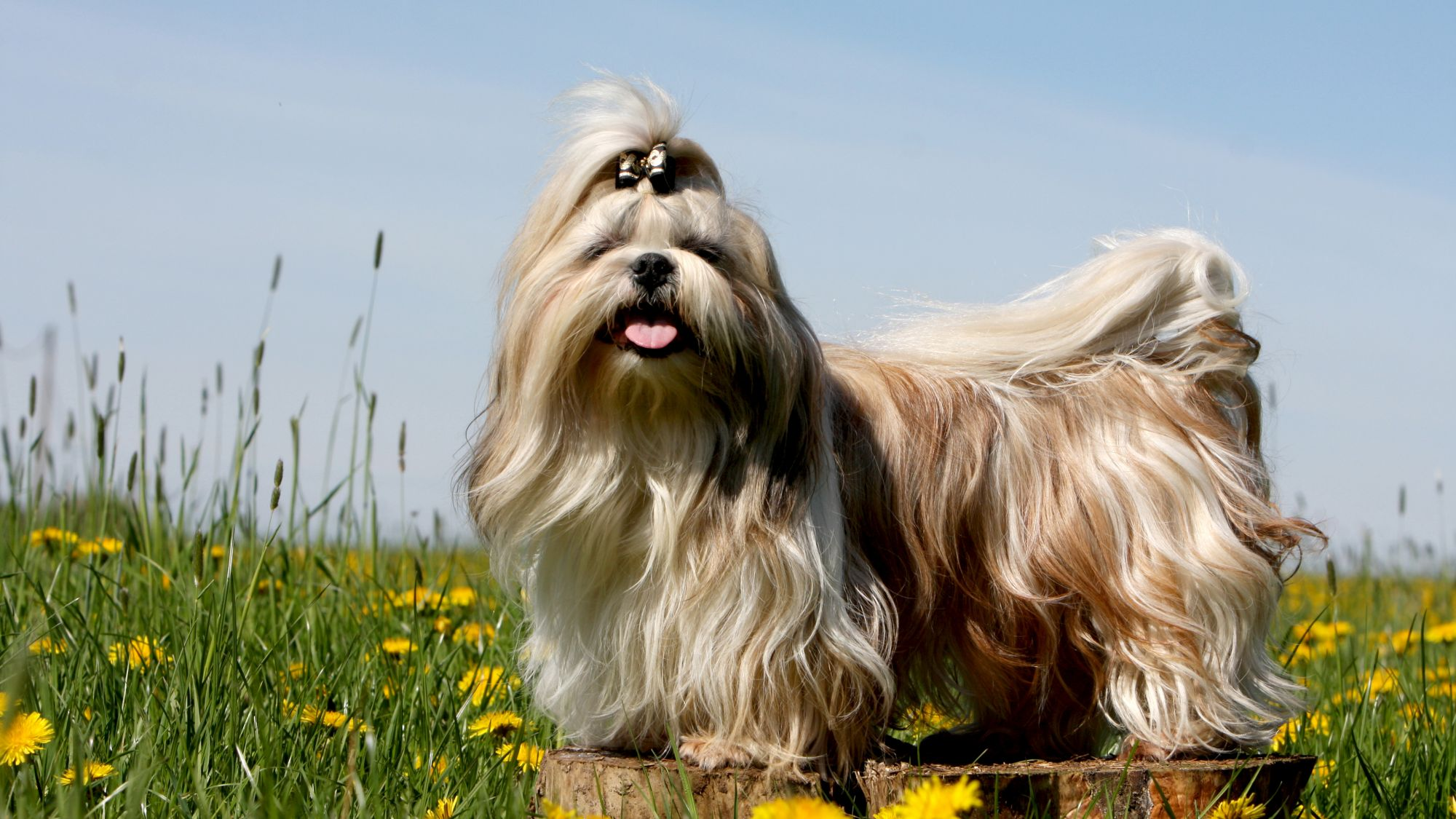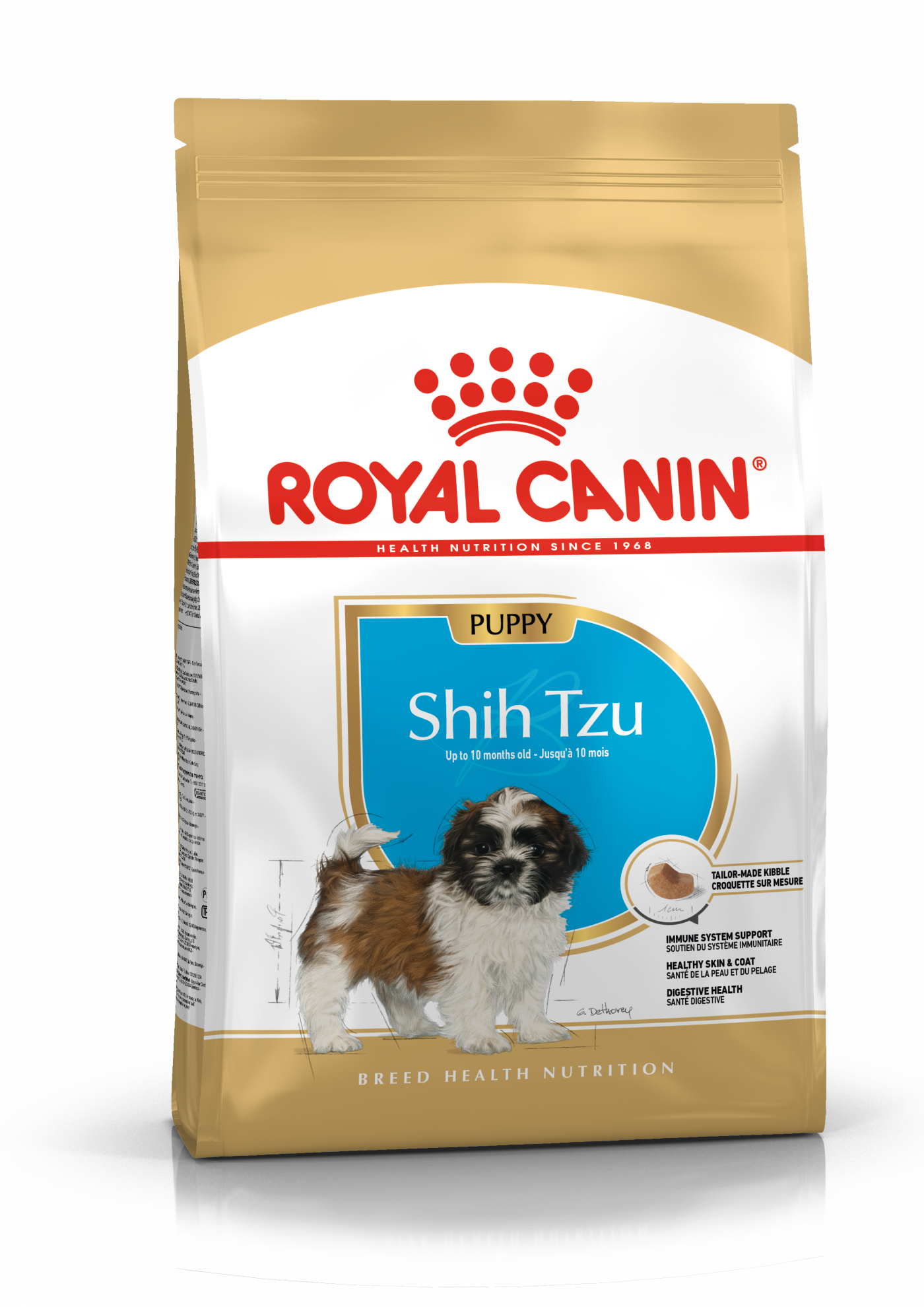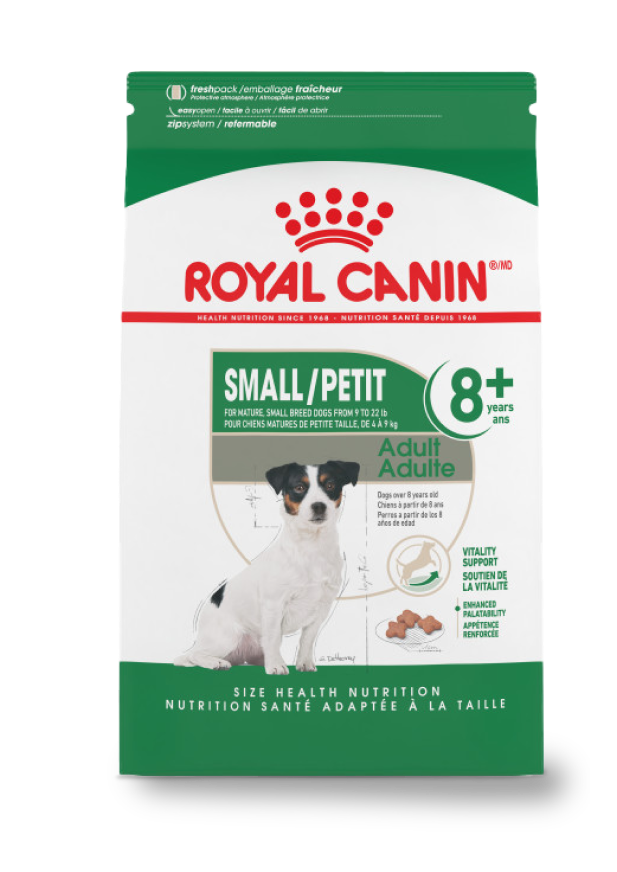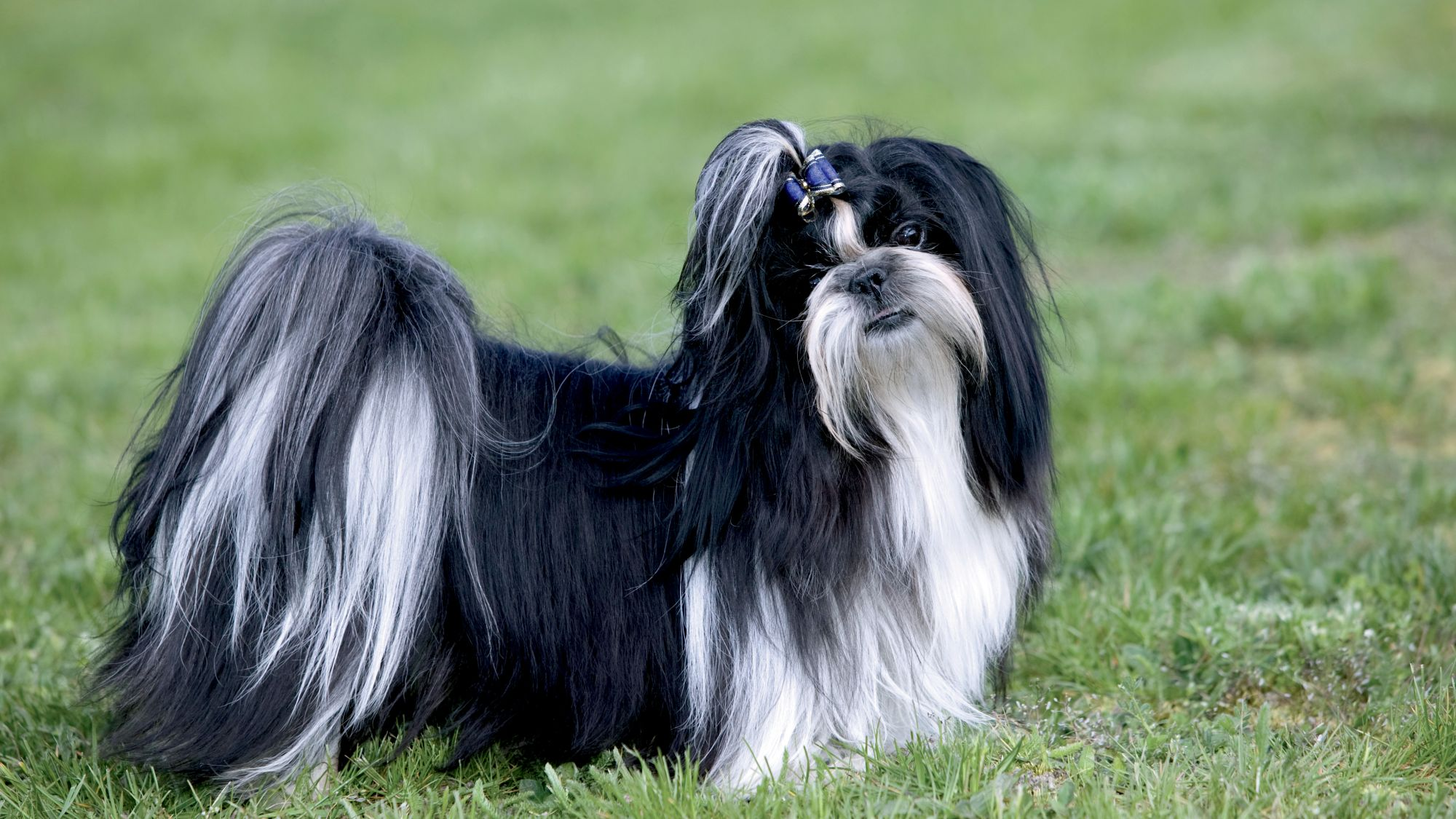Let's talk Shih Tzus
Official name: Shih Tzu
Other names: Shittsu, Tibetan Lion Dog, Chinese Lion Dog, Chrysanthemum
Origins: Tibet/China
Drooling tendencies
1 out of 5Grooming needs
4 out of 5Shedding Level
3 out of 5Barking tendencies
3 out of 5Energy level*
4 out of 5Compatibility with other pets
4 out of 5Warm weather?
1 out of 5Cold weather?
2 out of 5Suited to apartment living
5 out of 5Can stay alone
2 out of 5Family pet?*
4 out of 5
| Male | Female |
|---|---|
| Height | Height |
| 23 - 27 cm | 23 - 27 cm |
| Weight | Weight |
| 4.5 - 8 kg | 4.5 - 8 kg |
| Life stages | |
|---|---|
| Puppy | Adult |
| 2 to 10 months | 10 months to 8 years |
| Mature | Senior |
| 8 to 12 years | 12 to 20 years |
| Baby | |
| Birth to 2 months | |
Drooling tendencies
1 out of 5Grooming needs
4 out of 5Shedding Level
3 out of 5Barking tendencies
3 out of 5Energy level*
4 out of 5Compatibility with other pets
4 out of 5Warm weather?
1 out of 5Cold weather?
2 out of 5Suited to apartment living
5 out of 5Can stay alone
2 out of 5Family pet?*
4 out of 5
| Male | Female |
|---|---|
| Height | Height |
| 23 - 27 cm | 23 - 27 cm |
| Weight | Weight |
| 4.5 - 8 kg | 4.5 - 8 kg |
| Life stages | |
|---|---|
| Puppy | Adult |
| 2 to 10 months | 10 months to 8 years |
| Mature | Senior |
| 8 to 12 years | 12 to 20 years |
| Baby | |
| Birth to 2 months | |

Get to know the Shih Tzu
All you need to know about the breed
With its illustrious canine heritage, the Shih Tzu has always had a certain exoticism about it. Originating in the Imperial Palace of Chinese emperors, where the breed lived exclusively for several centuries, they were considered by many people to be sacred. As such, it is often treated with a certain reverence.
Certainly, this sprightly breed does have a special sort of charm. With a temperament that is loyal, affectionate, and gentle, the Shih Tzu also has a natural intelligence. Then there are those gorgeous lion-like looks.
Famed for their long silky tresses, it’s true that the Shih Tzu’s coat requires a fair amount of grooming. But it’s all part of the pleasure that comes with having this breed. Also, as they require minimal exercise compared to many dogs, they are lower maintenance in other ways. The compact size of the Shih Tzu means they will fit into most home set-ups, too.
They do have minds of their own, so training the Shih Tzu can be a little challenging at first. But with a bit of gentle persuasion, and plenty of encouragement along the way, they grow into well-mannered adults. The Shih Tzu also has a good lifespan, too, and have been known to live to 20 years of age.
Given all this, it’s perhaps no surprise that they also seem to be popular with the celebrity community. Among the many well-known names to have owned a Shih Tzu are Mariah Carey, Beyoncé, Colin Farrell, Bill Gates, and even Queen Elizabeth II. In summary, this is a very rewarding breed of little dog – and one that is, indeed, fit for an emperor.

Facts about Shih Tzus
1. What’s in a name?
Wondering how to say the name ‘Shih Tzu’? Well, in the west, it’s pronounced “sheed-zoo” or “sheet-su”. However, in China, the word is pronounced as “sher-zer”.
2. A dog with flower power
Another interesting fact about the Shih Tzu is that they are sometimes known as ‘Chrysanthemum’ dogs. This is partly because of their resemblance to the flower but also because chrysanthemums are an important cultural symbol in China.
History of the breed
As a breed that is more than 1,000 years old, the Shih Tzu has a long and illustrious history – and an impressive heritage. For many centuries, they were owned exclusively by the emperors of China, with no one outside the palace allowed to have one.
Going back even further, the Shih Tzu is thought to have its origins in neighboring Tibet. The story goes that these elegant toy-breed dogs were developed by Tibetan Monks who probably offered them as gifts to the Chinese emperors. In any event, the Shih Tzu appears to be a cross between two Sino-Tibetan breeds, the Lhaso Apso and the Pekingese, and another Tibetan variety.
Cherished by successive emperors, the Shih Tzu lived the high life at the palace for hundreds of years but were little known outside the imperial court. In fact, the breed all but vanished by the early 1900s. Brought back from the brink, however, the Shih Tzu finally came to the attention of the outside world in the 1930s and hasn’t looked back since.
Initially, breed clubs were formed in Peking and, later, in England where the breed was refined even more. By the 1940s and '50s, their popularity had spread to the United States and they were recognized by the American Kennel Club in 1969. Today, they are among the most popular toy-breed dogs in the world.
From head to tail
Physical characteristics of Shih Tzus
1.Head
2.Face
3.Body
4.Tail
5.Coat

Things to look out for
From specific breed traits to a general health overview, here are some interesting facts about your Shih Tzu.
Keep a close check for any eye problems
While their bright brown eyes are one of their distinguishing features, Shih Tzus can suffer from a few potential issues in this area. These include cataracts, retinal detachment, corneal dryness, general inflammation, and a degenerative condition called progressive retinal atrophy. Also, because of their protruding shape, their eyes can be easily scratched or injured. The best advice? Check daily for anything out of the ordinary and, at the first sign of something unusual, contact your vet. It’s important to keep their hair out of their eyes by tying it up in a topknot or keeping it cut short.
They can be prone to respiratory issues
Because of the way their heads, faces, and airways are shaped, the Shih Tzu is known as a ‘brachycephalic’ breed. This means they can be susceptible to breathing difficulties – and, in some cases, fainting spells. For this reason, over-exercising Shih Tzus should always be avoided. It also means they have a poor ability to tolerate heat. Coupled with their thick coat, the Shih Tzu simply doesn’t cope well in hot weather. As a result, walks in the summer should be taken either first thing in the morning or at the end of the day when the temperature is cooler. To ensure you have the healthiest dog possible, always seek out a responsible and trusted breeder, and seek counsel from your vet if needed.
And watch out for any allergies in your dog
One other thing to be aware of is that the Shih Tzu may also develop atopic dermatitis: a hypersensitivity to environmental allergens such as pollen and dust mites. Also, the itch (pruritus) induced can then be complicated by secondary infections. It is recommended, therefore, to keep a close eye on your Shih Tzu’s skin health. Licking the paws, rubbing the face, and recurring ear infections are the most common signs of allergies. If they display any of these signs, it’s best to consult your vet. Unfortunately, dealing with a dog with allergies is not easy, but medicated shampoos, the proper diet, or specific treatments can help to improve the situation.
Tailored nutrition for Shih Tzus

When choosing food for a Shih Tzu, there are many factors to consider: their age, lifestyle, activity level, physiological condition, health and potential sensitivities. Food provides energy to cover a dog’s vital functions, and a complete nutritional formula should contain an adjusted balance of nutrients to avoid any deficiency or excess in their diet, both of which could have adverse effects on the dog.
Immune System Support
As puppies grow, they will experience big changes and new discoveries. During this key period, the puppy's immune system develops gradually. The formula helps support your puppy’s natural defenses as they develop through puppyhood via an exclusive complex of antioxidants, including vitamin E.
Digestive Health- The formula contains high quality and easily digestible proteins as well as prebiotics, to support digestive health and a balanced flora, contributing to optimal stool quality
Healthy Skin & Coat
Coat condition is a reflection of the dog's health and overall well-being. The formula helps to support the skin's role as a barrier with an exclusive complex of nutrients (EPA, DHA and Vitamin A) to help maintain a healthy skin and coat.

The main nutritional goals for adult Shih Tzus are:
Healthy Skin
Preserving the health and beauty of the skin and coat with the enriched addition of essential fatty acids (especially EPA and DHA), essential amino acids, and B vitamins to support the skin’s “barrier” function.
Coat Health
Shih Tzus are known for their continuous hair growth and the natural softness of their coat. This Shih Tzu exclusive formula contributes to maintaining coat health via the inclusion of omega-3 and 6 fatty acids as well as biotin.
Stool & Odor Reduction
Shih Tzu Adult helps reduce fecal smell and volume while supporting healthy digestion with highly digestible protein, a precise fiber content and high quality carbihydrate sources.
Exclusive Kibble
Shih Tzus are a brachycephalic breed (and they can have breathing problems). Therefore, the adult formula's shape, size and texture is perfectly designed for the Shih Tzus needs so it is easy for them to pick up and chew.

After 8 years old, Shih Tzus start facing the first signs of aging. A formula enriched with antioxidants will help maintain their vitality and an adapted phosphorus content will support their renal system. Aging is also accompanied by the modification of digestive capacities and particular nutritional requirements, so food for older Shih Tzus should have the following characteristics:
Vitality Support
Formulated with nutrients and a complex of antioxidants to help keep small dogs like Shih Tzus active and fight the first signs of aging.
Enhanced Palatability
The formula satisfies the appetite of small breeds with a special formulation and flavors.
Adapted Energy
Helps to maintain a healthy weight in small dogs by meeting their high energy needs while utilizing L-carnitine to promote fat metabolism.

Caring for your Shih Tzu
Grooming, training and exercise tips
Although they were bred to be a house companion, meaning they require less exercise than most, the Shih Tzu is still quite an active little dog. They are also quite social animals. As such, the Shih Tzu will benefit from short walks, a couple of times a day, to keep them fit and healthy and support their mental well-being. Just watch out for other larger dogs who may be boisterous around them. For your Shih Tzu's own protection, the dog park is best avoided. As this is a breed that does not do well in extremes of hot or cold weather, the Shih Tzu’s exercise should be organized accordingly. Outdoor adventures should be supported with indoor games to satisfy the Shih Tzu’s naturally playful personality.
The Shih Tzu has a luxurious double coat and the amount of grooming required will depend on the length. If you choose to keep their coat long, it will require a fair bit of maintenance. Ideally, your Shih Tzu will need a good brushing every day. To prevent matting, be sure to reach gently to the skin. As mentioned earlier, the hair on the top of the head should also be tied in a topknot or cut short to protect their eyes. Medium-length coats should be fine with some attention every two days and short coats every three. Shedding in the Shih Tzu is no more than average and can be less. A monthly bath is recommended, and brushing teeth, trimming nails and cleaning ears should all be part of the regular routine too.
While it’s true that they’re pretty smart, Shih Tzus can also have a stubborn streak, which can make training a bit of a challenge at times. Puppy classes are therefore a good idea. As they can sometimes struggle with housetraining, too, this can take slightly longer than average. However, with a little patience and plenty of positive reinforcement, they’ll soon get the hang of things. When you’re as small as a Shih Tzu, the world can seem like a big place, so early socialization with new people, pets and places is also recommended.
Although they were bred to be a house companion, meaning they require less exercise than most, the Shih Tzu is still quite an active little dog. They are also quite social animals. As such, the Shih Tzu will benefit from short walks, a couple of times a day, to keep them fit and healthy and support their mental well-being. Just watch out for other larger dogs who may be boisterous around them. For your Shih Tzu's own protection, the dog park is best avoided. As this is a breed that does not do well in extremes of hot or cold weather, the Shih Tzu’s exercise should be organized accordingly. Outdoor adventures should be supported with indoor games to satisfy the Shih Tzu’s naturally playful personality.
The Shih Tzu has a luxurious double coat and the amount of grooming required will depend on the length. If you choose to keep their coat long, it will require a fair bit of maintenance. Ideally, your Shih Tzu will need a good brushing every day. To prevent matting, be sure to reach gently to the skin. As mentioned earlier, the hair on the top of the head should also be tied in a topknot or cut short to protect their eyes. Medium-length coats should be fine with some attention every two days and short coats every three. Shedding in the Shih Tzu is no more than average and can be less. A monthly bath is recommended, and brushing teeth, trimming nails and cleaning ears should all be part of the regular routine too.
While it’s true that they’re pretty smart, Shih Tzus can also have a stubborn streak, which can make training a bit of a challenge at times. Puppy classes are therefore a good idea. As they can sometimes struggle with housetraining, too, this can take slightly longer than average. However, with a little patience and plenty of positive reinforcement, they’ll soon get the hang of things. When you’re as small as a Shih Tzu, the world can seem like a big place, so early socialization with new people, pets and places is also recommended.
All about the Shih Tzu
It’s true that the Shih Tzu can be a breed that’s prone to barking. But that’s only because they like to communicate what’s going on. As Shih Tzus will often bark at people or dogs passing the window, investing in some curtains or shutters may help. On the bright side, it does mean these little lap dogs also make good watchdogs.
The answer is yes, absolutely. As the Shih Tzu was bred to be a companion animal, and that has been the case for centuries, they form close bonds with their human families. The Shih Tzu also has a friendly and affectionate temperament and will thrive on attention from their owners.
Other breeds that might interest you
Read more on this topic
Sources
- Veterinary Centers of America
- Business Insider
- American Kennel Club
- Shih Tzu Expert
- Banfield Pet Hospital
Like & share this page